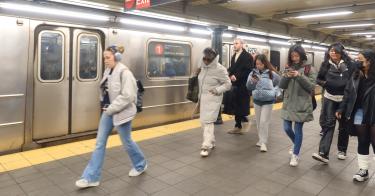New York City lost almost half a million people between July 2020 and July 2022. Yet the Big Apple seems intent on driving away more residents as well as tourists with its new “congestion charge,” or tax, just approved by the Metropolitan Transportation Authority.
Starting in June, unless legal challenges prevail, drivers will pay $15 per day to enter Manhattan’s Central Business District below 60th Street between 5 a.m. and 9 p.m. weekdays and 9 a.m. and 9 p.m. on weekends. Taxis are exempt from the $15 daily charge, but will pay an additional $1.25 per trip to the city, with ride share paying an additional $2.50 trip charge.
Proponents say that the tax will improve the air, reduce congestion, and fund public transit. But it will hurt elderly and poor people and contribute to the flight from the city.
And a congestion tax doesn’t necessarily reduce traffic jams. London’s congestion charge has been in place for over 20 years, yet London ranks top in the world in terms of traffic delays.
>>> Biden’s DOJ Blocking JetBlue-Spirit Merger Will Mean Higher Fares, Fewer Choices
The object of the tax is not to improve the New York City road system, which would qualify it as a user fee, but to shift drivers away from their cars to public transit and bail out subways and buses. Rather than going to repair potholes, build new underpasses, and fortify bridges, the funds will be turned over to the MTA for public transit.
Transit ridership would increase only marginally, by 1 percent to 2 percent, according to the MTA, but the taxes will prop up the failing system. Expected revenues are $1 billion a year, although one congressional report commissioned by Representative Josh Gottheimer (D., N.J.) anticipates revenues of over $3.4 billion.
This is an attempt to paper over the fundamental problem with public transit after the pandemic—fewer people are riding it, so transit systems nationwide are losing billions of dollars. Traffic volumes are back to 2019 levels, but ridership has stabilized at 71 percent of pre-pandemic levels, with total trips reduced from 10 billion to 7 billion annually, according to Arizona State University professor Steven Polzin, as people continue to do some work at home and others switch to personal vehicles for health and safety reasons.
That means subsidies from new taxes are needed to avoid laying off excess public-transit workers and cutting routes and frequency of service. This accelerates the death spiral of the transit system, because reduced service further discourages ridership. Buses and subway workers benefit from the tax on cars.
The Transport Workers Union of America, which represents New York’s transit workers, is one of the winners from the Congestion Charge, because its revenues are reduced if transit workers are laid off. Transit workers pay union dues to the TWU. Fewer transit workers mean lower salaries and perks for union officials, and less money available for political contributions. John Samuelsen, the TWU president, made $383,000 in 2022, according to Labor Department filings.
The congestion charge is a cruel policy for older and handicapped people who live in Manhattan below 60th Street, who find it difficult to take public transit and can’t afford taxis. Those who live above 60th Street, or in other boroughs such as Brooklyn, will not be affected.
Giving a ride to an elderly person to go to a doctor’s appointment, or picking up a parent in the congestion zone to go to your house in New Jersey for lunch, will now cost an extra $15 per day. Public transit doesn’t go everywhere, and some senior citizens find it hard to navigate the stairs in the stations. New York City’s Access-A-Ride program is open to some, but a shared-ride program with frequent delays is not as convenient as personal transportation. Worse, crime has skyrocketed all over New York, particularly for vulnerable people in subways.
>>> The Great Train Robbery: Taxpayer Subsidies for Amtrak Should Be Derailed
The tax disproportionately hurts poor people and small businesses. Those earning under $50,000 receive a 25 percent discount on the tax, but only after the first ten trips in a month—an expenditure of $150. The discounted cost is $11.25 per trip, or $56.25 for five days a week. Many small businesses cannot do without their vehicles.
If the Big Apple truly wanted to reduce congestion, MTA could reduce some of the lightly used bike lanes and bike docking stations in the roadways. It could raise the metered price for curbside parking to keep spaces free for delivery vehicles, so they wouldn’t have to double-park to unload, causing frequent traffic jams. And New York City could get rid of the dining areas that have spread from the restaurants to the roads.
The pandemic work-from-home policies have continued well after the end of the pandemic, causing major problems to the office market and city businesses, as well as to the public-transit system. New Yorkers want the city to be doing everything that it takes to get people into the office, rather than discouraging them with additional fees. The revenues gained from the new tax may be swamped by loss of income, business, and property taxes as more people leave.
Rather than solve its problems, MTA prefers a new tax that it disguises as a congestion charge. But people don’t like to be without their cars. This will be counterproductive and drive more New Yorkers to Florida, Texas, and other low-tax states—increasing the death spiral of the city and the transit system.
This piece originally appeared in the National Review




